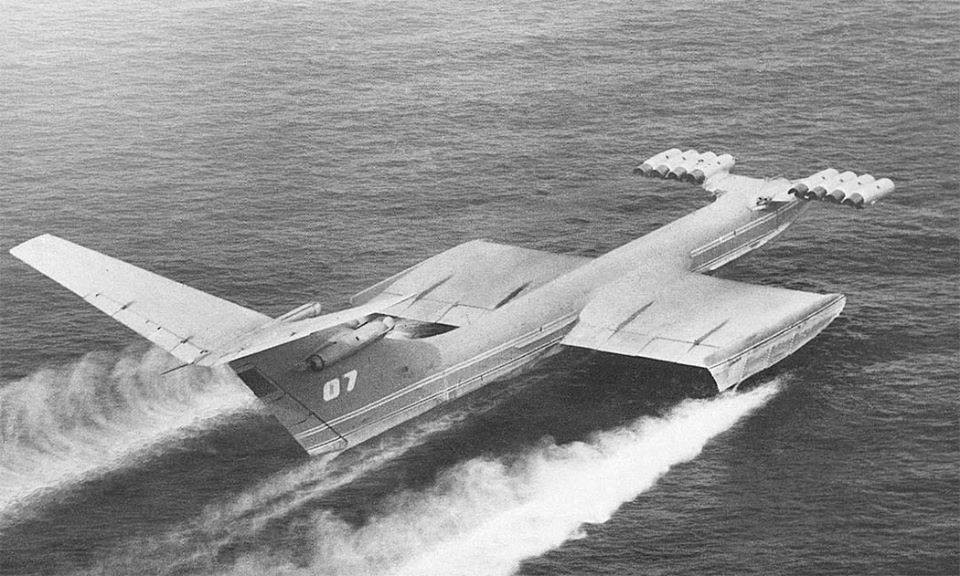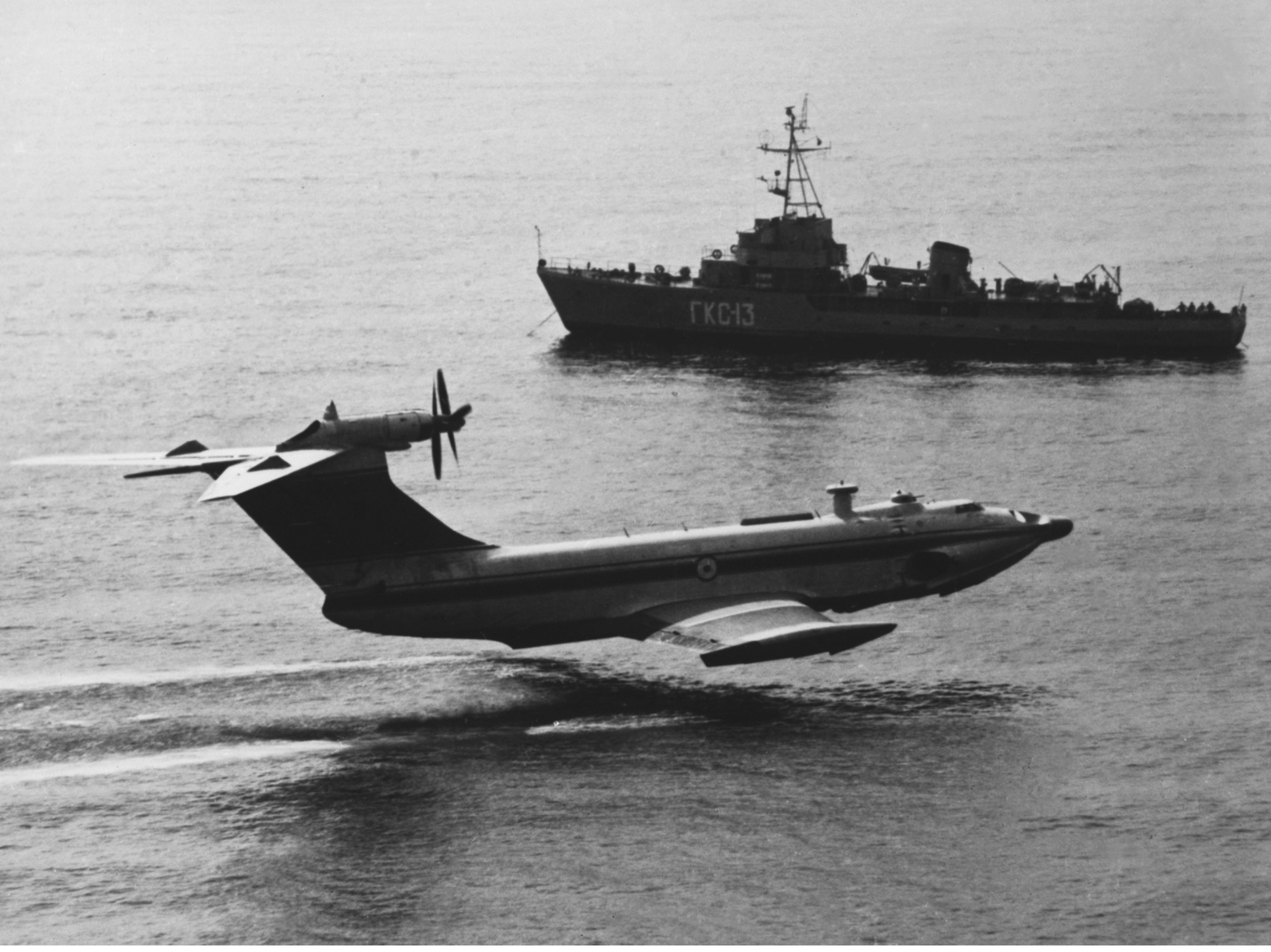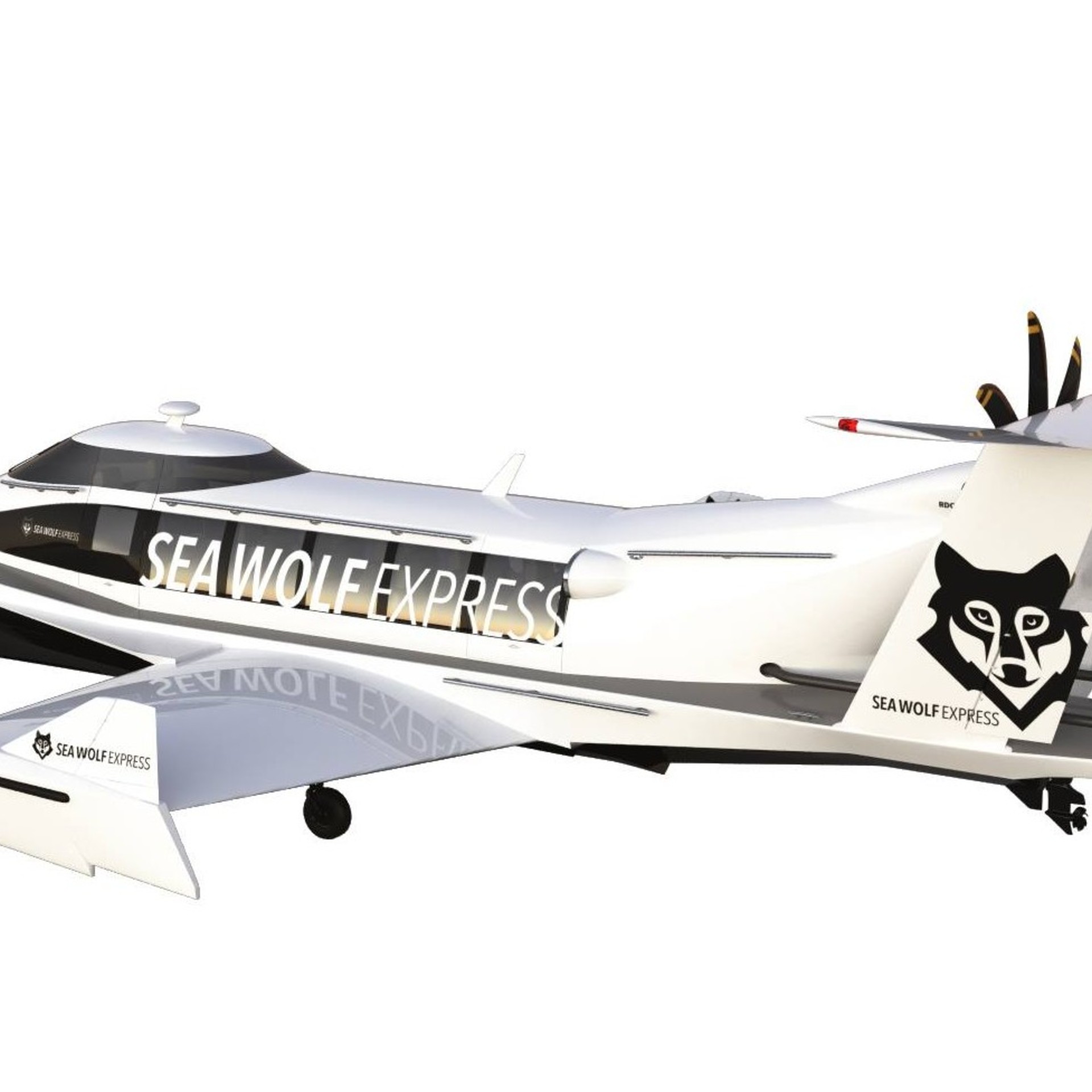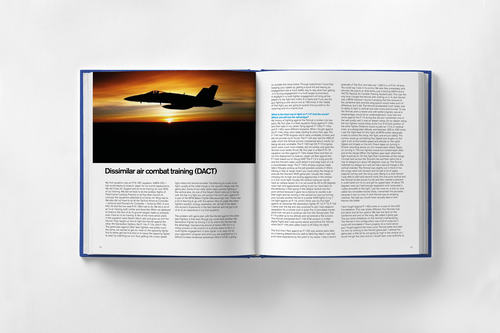What the hell are ekranoplans and why have they never really taken off?

Ekranoplans are among the most extraordinary machines ever built. The Soviet KM remained the largest aircraft in the world during the entirety of its existence. It was 20 metres longer than a Boeing 747, weighed over a million pounds and flew faster than a Spitfire just above the surface of water. Ever when Ekranoplans or ‘wing-in ground-effect’ vehicles are not warlike giants they are unique. Here’s an explanation of how they work, and perhaps why the big breakthrough has not yet happened.
By Jim Smith
What is an Ekranoplan? Well, Ekranoplan is the Russian term for a class of air vehicle otherwise known as a Wing-in-Ground-Effect craft, or WIGE.
The best-known example of an Ekranoplan is the Caspian Sea Monster, otherwise more properly known as the Central Hydrofoil Design Bureau KM, a very large WIGE weighing 240 tonnes empty, and up to 500 tonnes at maximum weight. The KM could cruise at up to 230 knots and was designed to operate at about 10 m above the surface of the water. The envisaged role was as a high-speed, high-payload, troop or equipment carrier, flying below radar detection over the sea.

So, let’s unpack Wing-in-Ground-Effect craft, to explain their operating principles, and from there, discuss their potential applications, and some of the issues that may affect their operation.

Wing Lift and Downwash
A conventional lifting wing can be thought of as generating lift through circulation about the wing, the circulation being shed at the wing tips as trailing vortices. These are the familiar vortices, often seen behind manoeuvring aircraft, but also visible as part-span vortices trailing from flaps, because of the change in circulation at the end of the flap. The circulation is generated as a result of the shape of the aerofoil, its camber and its angle to the airflow.
If we want to consider a simple representation of a lifting wing, we can represent this as a ‘bound’ vortex, lying across the span, with trailing vortices at the wing tips (this is called a lifting-line representation by aerodynamicists). In a steady flow, this representation will result in additional local air speed above the wing, and reduced speed below, and the pressure difference between the two surfaces of the wing will generate lift. Considering this model a little more, we can see that a lifting wing will generate an upwash ahead of the leading edge and outside the wing tips, and a downwash behind the wing, and between the trailing vortices.

This is a simplified representation is valid for low-speed flows without considering air viscosity. However, despite this, the model works surprisingly well, in describing the flow about a lifting wing.

Incidentally, the upwash outside the wing tips is why migrating geese travel in large V-shaped formations – each bird is exploiting the upwash outside the wing tip of the neighbouring bird ahead of it, reducing the energy it needs for flight.
Ground Effect
Pilots and their passengers are familiar with ground effect as a cushioning influence felt as the aircraft flares for touchdown. From a flow perspective, the ground or sea surface acts like a mirror. As the aircraft approaches the ground, the flow around it is changed because the downwash generated by the aircraft is modified.
Mathematically, this can be represented by introducing a mirror image of the aircraft into the flow, with the ground surface acting as the mirror. The equal and opposite influence of the mirror image aircraft increases as the physical aircraft and its virtual mirror image near the ground. The aircraft experiences greater lift, and less drag than in its usual free-air flying conditions.

This results in the ‘float’ experienced by the pilot as the aircraft nears the ground. Normally, at least for light aircraft pilots, this is not a problem, and generally increases the pilot and passengers satisfaction with the flight. But if you have a large wing-span, like a sailplane or a U-2, ground effect can be a real issue – hence the need for spoilers, brake chutes and so on.
For civil transports, float is not good either, as it increases field length required, and can be particularly dangerous in wet conditions. A very gentle touchdown for an airliner will not only have used more runway than necessary, it can, in wet conditions, cause the aircraft to aquaplane, reducing braking action and dramatically increasing landing distance. Hence the desirable airliner landing is actually ‘firm’, and will be followed by the use of spoilers, lift dumpers and reverse thrust, all of which reduce landing distance and the likelihood of aquaplaning in wet conditions..
Sadly, this site will pause operations if it does not hit its funding targets. If you’ve enjoyed an article you can donate here and keep this aviation site going. Many thanks
Wing in Ground Effect Craft
Flying in ground effect seems to me a bit like slipstreaming a truck going uphill in my kombi. You get a boost from the aerodynamics of the truck, or from flying within a wingspan of the surface. The reduction in drag (and increase in lift for a WIGE craft) is real, and beneficial. Less power is required to lift a given load, or to get up the hill at the speed of the truck, and, for an Ekranoplan or WIGE, you can travel far faster than any boat.
But the geometry is a constraint. I don’t really recommend slipstreaming trucks in the kombi, because great awareness is required, and the penalty for mistakes could be severe. For WIGE, the beneficial effects taper off to near zero at about one wingspan above the surface. At this low altitude, the scope for manoeuvre is limited, because any significant roll angle may bring the ‘down’ wing tip too close to the surface. Similarly, the ability to climb to greater than a wingspan above the surface may be helpful in avoiding surface obstructions, in manoeuvring, or in passing over coastal features, but will come at the expense of requiring additional power.
What does this mean for WIGE design? At present, practical WIGE seem to fall into two distinct categories – relatively small people movers and absolute behemoths.
The smaller craft typically have capacity from 2 to a dozen or so people. The larger end of this group is represented by the Sea Wolf Express, proposed for use as a Baltic Ferry, while craft such as the RFB X-114 represent the sporting and utility end of the market.

The most successful Ekranoplan is the 125 tonne A-90 Orlyonok, but this has itself been dwarfed by the Caspian Sea Monster, and would have been further dwarfed by the Boeing Pelican Ultra concept, which was for a ground effect aircraft with 500 ft wingspan and a payload of 1270 tonne. The Pelican was supposed to take-off and land from the ground, but cruise over the sea most of the time.
Contrasting attitudes to WIGE Craft
One of the most interesting aspects of Ekranoplans or WIGE, is that there is some uncertainty about whether they are boats that fly, or flying-boats operating only at low altitude. The conceptual difference may appear trivial, but it seems to lead to substantial differences of view about their attraction or utility.
The International Maritime Organisation (IMO) has identified three classes of Ekranoplans, which apply for craft carrying 12 or more passengers, based on the heights at which the craft can operate.
These are defined as follows:
Type A: capable only of operating within Ground-Effect i.e. no more than 1 wingspan above the surface;
Type B: temporarily capable of flying out of ground effect, but at no more than 150m above the surface;
Type C: capable of flying out of ground effect, at heights above 150m.
If we consider these vehicles to be ‘craft’ rather than ‘aircraft’, we can see some attractions. For example, a vehicle like the Sea Wolf Express could make a very impressive fast passenger ferry, as is envisaged for that craft, operating between Estonia and Finland.

A smaller version with perhaps two-seats, could be great fun as a sort of ‘flying jet-ski’ for whizzing about over rivers, lakes and calm seas.
And, if you are in the invasion or urgent freight business, the Russian Ekranoplans or Boeing Pelican, with payloads in the hundreds of tonnes and speeds above 200 knots look pretty impressive.
Support Hush-Kit with our high quality aviation themed merchandise here


Potential Issues
So, what are the drawbacks? Why are sporting WIGE, fast ferries and Ekranoplan freighters not everywhere?
If we look at each of these potential uses in turn, we can see some potential issues. For all of these craft, the ability to become airborne will require quite a lot of power, mainly to overcome water drag up to the point where the craft can reach planning speed across the surface.

This implies, for the sporting end of the market, significantly increased cost compared to a jet-ski. In addition, thinking about the alternative uses of sporting boats, it is not going to be possible to either fish, or tow water-skiers, behind a flying craft. Great for a runabout, or for what the Australians would call ‘hooning about’, but potentially an expensive alternative to either a jet-ski or a speedboat.

Operating economics are going to be the key driver for the fast ferry application, as well as safety and environmental considerations. One key problem faced by many operators of such craft is that, generally, the waterborne small fast ferries cannot carry cars, and this is likely also to be true for Sea Wolf Express class WIGE. As a result, operations are generally limited to passenger carriage, such as the routes operated in Sydney Harbour, along the Brisbane River or the Thames in London. Combinations of factors, such as bridges, tides and noise constraints, are likely to limit the practical applications of WIGE ferries around cities. This is not to say that short, high volume passenger services, linking destinations with good public transport at each end, such as proposed across the Baltic, would not be viable. But it is to suggest that this might be rather a niche market.
What about the behemoths? Well, the Russian giants have certainly demonstrated that such vehicles can be built and flown, and provide evidence that the carriage of a large payload is going to require huge dimensions and plenty of engine power. The Boeing Pelican Ultra concept is an interesting case study – although only a concept, the eventual design was huge, with 500ft wingspan, and a payload well in excess of 1000 tonnes. So, it can be done – why is this not happening? Well, largely because the commercial freight business is insanely competitive. Costs are pared to the minimum, and great attention is paid to operating economics. If, for example, you are shipping cars to the US in volume, it makes no sense to look at anything other than a ship (or building the cars in the US in the first place). The degree of urgency that would require such freight to arrive in a couple of days simply is not there. Far better and cheaper, to use either a container ship for general freight, or a specific type of vessel for more specialist needs.
Pre-order your copy of The Hush-Kit Book of Warplanes here
“the thinking-man’s Top Gear… but for planes”.

-
Pre-order your copy here.
Who has the ability to ignore these commercial realities? Well, the military, who might have a need for rapidly, and relatively covertly, landing tanks, troops, vehicles and artillery on the beach of some neighbouring country. Hence the proposed applications of the giant Ekranoplans are exclusively military. An additional factor seems to be that for these craft size does matter, and, in general, the bigger things are, and the more engines they need, the more they cost, not only to develop, but to acquire and operate.
The other common issue that will undoubtedly require some thought is the licensing of operators. The IMO approach is all very well, but, if the intent of flying out of ground effect (Class B and C) is to fly over bridges, vessels, potentially isthmuses and small islands, then the operation is moving into a zone where aircraft operating requirements may come into play.
Ekranoplans as Aircraft
What happens if you look at Ekranoplans and WIGE, not as watercraft, but as a new class of flying-boat? A couple of big issues immediately become apparent.
Firstly, if even a small WIGE is going to require a pilot’s license for its operation, and all the reporting and maintenance procedures that come with aviation, then the costs of either commercial or private operation are going to increase markedly.
And secondly, the existing airborne alternatives are immediately going to come to mind. One only has to consider aviation in Alaska to identify the large market for small utility aircraft operating as floatplanes. At the small to medium size level of operation, there is certainly a valid question as to whether a Cessna 206 or 208, or a Twin Otter class floatplane, might not be a better bet, particularly where something of the nature of a Cessna Grand Caravan on floats could be used, giving the flexibility of either land or water-based operation. All at a higher cost than a conventional ferry, of course, but fast and flexible.

Indeed, at this scale, it is difficult to regard the WIGE as anything other than an inefficient flying-boat, with small wing size that constrains operations to very low level, and increases the power needed to get airborne, and hence acquisition cost.
There is currently no military equivalent to the Ekranoplan ‘deliver the landing force to the beach’ capability except, perhaps for the large hovercraft used in small numbers by some Nations. But the utility of using 747 and similar freighters for delivering urgent air freight has become all too apparent in recent weeks as PPE and other equipment is moved, largely from China, to the rest of the world. And it is hard to look past the fleets of military freight aircraft as a capability for moving urgent military supplies to wherever the operational need demands.

So, reluctantly, I am forced to the view that the current Ekranoplan and WIGE systems are niche capabilities, looking for a viable market. I’d love to have a go in a small 2-person flying jet-ski, especially if no special operating license is required. But even given that desire, I am not sure I could get sufficient utility out of such a device to justify buying one.

The Sea Wolf Express Baltic fast ferry venture is an exciting opportunity, and there may well be other routes where similar ventures would be attractive, such as Vancouver to Victoria BC, or even Southampton to the Isle of Wight.
However, any operator is going to look hard at the alternatives – conventional vessel, hydrofoil, hovercraft or aircraft.
Anyone fancy building an Ekranoplan ferry for the ride across to Tasmania from Melbourne?
Pre-order your copy of The Hush-Kit Book of Warplanes here
The Hush-Kit Book of Warplanes is a beautifully designed, highly visual, collection of the best articles from the fascinating world of military aviation –hand-picked from the highly acclaimed Hush-kit online magazine (and mixed with a heavy punch of new exclusive material). It is packed with a feast of material, ranging from interviews with fighter pilots (including the English Electric Lightning, stealthy F-35B and Mach 3 MiG-25 ‘Foxbat’), to wicked satire, expert historical analysis, top 10s and all manner of things aeronautical, from the site described as
 “the thinking-man’s Top Gear… but for planes”.
“the thinking-man’s Top Gear… but for planes”.
The solid well-researched information about aeroplanes is brilliantly combined with an irreverent attitude and real insight into the dangerous romantic world of combat aircraft.

FEATURING
- Interviews with pilots of the F-14 Tomcat, Mirage, Typhoon, MiG-25, MiG-27, English Electric Lighting, Harrier, F-15, B-52 and many more.
- Engaging Top (and bottom) 10s including: Greatest fighter aircraft of World War II, Worst British aircraft, Worst Soviet aircraft and many more insanely specific ones.
- Expert analysis of weapons, tactics and technology.

- A look into art and culture’s love affair with the aeroplane.
- Bizarre moments in aviation history.
- Fascinating insights into exceptionally obscure warplanes.
-
Pre-order your copy here.


Don’t worry folks, we are working on those.
http://Www.aquila-global.com
Interesting to see what that development will look like, as I guess a larger car carrying craft would open up a much larger market.
Jim,
Are you saying the initial Thrust requirement is due to the high water drag, planing etc? I’ve seen footage of the mid size soviet wig and it appeared to blast the front jet efflux under the leading edge to lift the aircraft. Was this the big Thrust driver and do you have any rough idea how much “hp/lb” this required?
The personal jetski wig exists, at least as a concept and I agree sounds fantastic (maybe hitting the water at 100kts could be a bit of a downer though…)
http://flynano.com/
https://newatlas.com/the-skimmer-100-kmh-ground-effect-recreational-water-toy/6864/
You have to get the craft planing, and directing the thrust down at an angle will provide a direct lifting component. Probably best not to direct under the wing, because that would result in a suction force. Once the craft gets onto the step and starts planing, it will then have to accelerate to flying speed, which will almost certainly be a greater speed than required for a ‘normal’ boat. There will be a trade-off depending on Class. In-ground effect only will have smallest wings; models designed to fly out of GE will have bigger wings and lower take-off speeds.
So – overcoming water drag to get to planing speed, and acceleration to get to flying speed are likely to determine power required, and this will be greater than for a convetional boat.